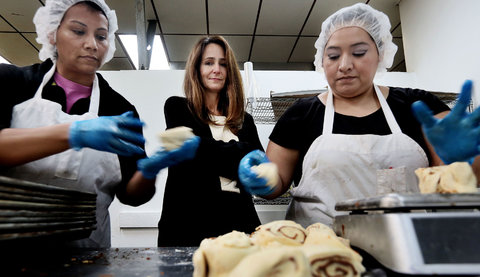 Sandy Huffaker for The New York Times Rachel Shein, center, is trying to figure out how to comply with the new health insurance law.
Sandy Huffaker for The New York Times Rachel Shein, center, is trying to figure out how to comply with the new health insurance law.
Case Study
What would you do with this business?
We just published a case study about Baked in the Sun, a wholesale bakery and distributor trying to decide how best to comply with the Affordable Care Act, which requires businesses with 50 or more employees to offer health insurance or pay a penalty. The company, owned by Rachel Shein and Steve Pilarski, who are married, started out making scones 16 years ago and expanded with the growth of coffeehouses. Baked in the Sun now produces nearly 200,000 items per day — almost 200 different products, including brownies, coffee cakes, muffins and cookies — and employs nearly 100 people in San Marcos, Calif.
Ms. Shein, who is chief executive, needs to decide if the owners will provide health insurance, which they estimate will cost up to $108,000 per year, or pay the penalty, which they estimate will cost $130,000. One benefit of paying the penalty is that the company would not have to take on the burden or expense of managing the insurance plan, which Ms. Shein estimates would take $10,000 of staff time. She is also considering a third option: outsourcing certain jobs to reduce staff. That is because businesses with 50 or fewer employees will be exempted from the law. It is important for Ms. Shein to make a decision soon on staffing levels because the number of full-time workers a business employs in 2013 will determine its status in 2014. Ms. Shein said she believes all workers should have health insurance, and she and her husband have offered it to employees in the past, but most are young and healthy and have not been receptive to plans that require them to contribute.
Below, you will find the recommendations of a tax accountant, an economist and another baker. Please use the comment section to tell us whether you agree or disagree with their advice — and to offer your suggestions for Ms. Shein and Mr. Pilarski. Next week, we will publish a follow-up.
John G. Ebenger, an accountant in the tax practice of Berkowitz Pollack Brant Advisors and Accountants in Miami: “It is a challenging situation, especially since the details have not been fully worked out. The bakery could opt to bite the bullet and pay the penalty next year, with plans to revisit the types of insurance that become available in 2014. With a year to plan, insurance companies will come up with more options for employers.”
Jonathan Gruber, an economics professor at M.I.T. who advised the Obama administration on health care reform: “Rachel and Steve face a difficult decision, but it seems that the third option to reorganize production and outsource functions to end up with fewer than 50 workers will be too expensive to make much sense. Offering insurance won’t cost much more than the penalty, and in an industry where many of their competitors don’t offer insurance, they could advertise themselves as a better place to work.”
Jody Hall, owner of Cupcake Royale, with 80 employees in Seattle, and a leader of the Main Street Alliance, a national network of state-based small-business groups: “I’d recommend offering health care insurance for full-time employees, like we do at Cupcake Royale, as part of our responsibility to help strengthen the health of our employees, our community, and our business. Ms. Shein is probably overestimating her costs because not all employees will use the health insurance she offers. At our bakery only about half our employees use the health insurance we provide. Some are under 26 and covered by parents, others have spouses with coverage, and some just choose not to take it. Small businesses like mine who have been offering health care will be better off when all businesses are paying into the system because the cost increases will slow down.”
What do you think?
Article source: http://boss.blogs.nytimes.com/2013/03/20/should-a-bakery-with-more-than-50-employees-offer-health-insurance/?partner=rss&emc=rss